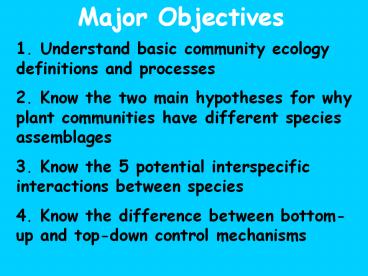Major Objectives - PowerPoint PPT Presentation
Title:
Major Objectives
Description:
Major Objectives 1. Understand basic community ecology definitions and processes 2. Know the two main hypotheses for why plant communities have different species ... – PowerPoint PPT presentation
Number of Views:61
Avg rating:3.0/5.0
Title: Major Objectives
1
Major Objectives
1. Understand basic community ecology definitions
and processes 2. Know the two main hypotheses for
why plant communities have different species
assemblages 3. Know the 5 potential interspecific
interactions between species 4. Know the
difference between bottom-up and top-down control
mechanisms
2
What is a Community?
A collection of all the populations of different
species that inhabit a particular area.
Communities differ in SPECIES RICHNESS and
RELATIVE ABUNDANCE
3
(No Transcript)
4
(No Transcript)
5
Beaver (Castor canadensis)
Ecosystem Engineer
6
Beaver Lodges
7
Ecosystem Engineer
keystone species
8
Pisaster spp. is a keystone species
9
(No Transcript)
10
(No Transcript)
11
(No Transcript)
12
Competitive Exclusion Hypothesis
Two species competing for same limited resource
can not exist
13
Why do plant communities have different species
assemblages?
Individualistic Hypothesis
A community is the result of chance because of
species having similar abiotic requirements
14
Interactive or "Organismic" Hypothesis
A community is the result of closely linked
species locked in by mandatory biotic interactions
15
(No Transcript)
16
(No Transcript)
17
Species Interactions
Parasitism
18
(No Transcript)
19
Interspecific InteractionPredation
20
- Cryptic coloration, or camouflage
21
- Aposematic coloration
- Warns predators to stay away from prey
22
- Batesian Mimicry
- A palatable or harmless species mimics an
unpalatable or harmful model
Frequency-dependent Batesian mimicry David W.
Pfennig, William R. Harcombe and Karin S.
Pfennig Nature 410, 323(15 March
2001) doi10.1038/35066628
Frequency-dependent Batesian mimicry David W.
Pfennig, William R. Harcombe and Karin S.
Pfennig Nature 410, 323(15 March
2001) doi10.1038/35066628
Frequency-dependent Batesian mimicry David W.
Pfennig, William R. Harcombe and Karin S.
Pfennig Nature 410, 323(15 March 2001)
The proportion of carnivore attacks on ringed
replicas of scarlet kingsnakes (top left a mimic
of eastern coral snakes) and sonoran mountain
kingsnakes (top right a mimic of western coral
snakes) increased with a, latitude (y - 13.314
0.391 x , P lt 0.035, R2 0.345) and b,
elevation (y - 0.329 0.00032 x, P lt 0.014, R2
0.310). Horizontal dashed line proportion of
attacks on ringed replicas expected under
randomness. Vertical dashed line maximum
latitude and elevation for coral snakes in North
Carolina and Arizona, respectively.
23
- Müllerian mimicry
- Two or more unpalatable species resemble each
other
The viceroy (Limenitis sp. right) and monarch
(Danaus sp.) butterflies look very similar but
may differ in their palatability to avian
predators.
24
Interspecific InteractionHerbivory
- The process in which an herbivore eats parts of a
plant
25
Mutualism
26
Mutualism
27
Commensalism
28
Competition
Life in the shadePlants can tell the
difference between the shade of an inanimate
object and the shade of another plant. When a
plant detects competition from neighboring
plants, it initiates a set of responses, called
collectively the shade avoidance syndrome, that
alter its growth and physiology. A rapid and
transient increase of newly synthesized auxin via
a newly discovered auxin synthesis pathway allows
plants to elongate and grow toward the sun.
Image Courtesy of Dr. Jean-Luc Ferrer, Salk
Institute for Biological Studies
29
Nuetralism
30
Species "A"
0
-
-
0
Species "B"
31
Species "A"
0
No interaction
-
No interaction
-
0
Species "B"
32
Bottom-Up Control
33
Top-Down Control
34
Trophic Structure
Feeding relationship between organisms
35
(No Transcript)
36
Major Objectives
1. Understand basic community ecology definitions
and processes 2. Know the two main hypotheses for
why plant communities have different species
assemblages 3. Know the 5 potential interspecific
interactions between species 4. Know the
difference between bottom-up and top-down control
mechanisms































